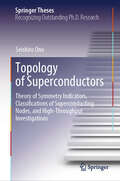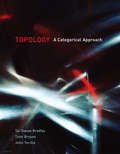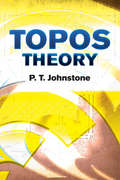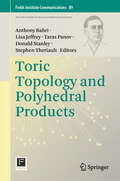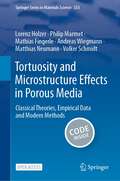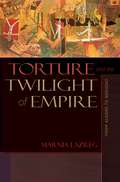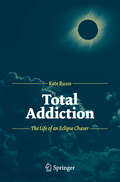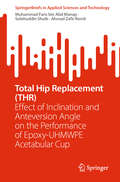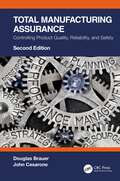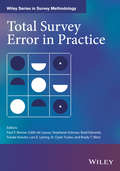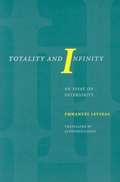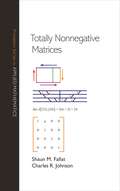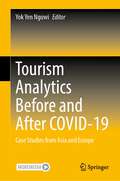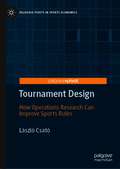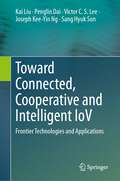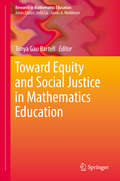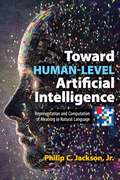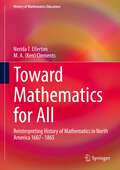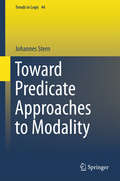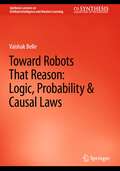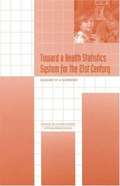- Table View
- List View
Topology of Superconductors: Theory of Symmetry Indicators, Classifications of Superconducting Nodes, and High-Throughput Investigations (Springer Theses)
by Seishiro OnoThis book develops a symmetry-based approach to superconductors, which enables us to efficiently diagnose topological and nodal superconductivity. Superconductivity has fascinated physicists since its first discovery. In particular, unconventional superconductivity, which arises from unusual attractive interactions between electrons, has been intensively studied for the last few decades. More recently, it turns out that topological nature of superconductivity is closely related to how electrons pair up. After reviewing the basic concepts of the symmetry-based analysis of band topology, the first part of this book discusses a generalization of symmetry-based indicators—an efficient way to diagnose topological insulating phases without full information on wave functions—to superconducting phases. The second part of this book develops a novel scheme to extensively classify superconducting nodes—geometry of gapless regions in the Bogoliubov quasiparticle spectrum—based on band topology.Finally, combining these two parts, this book proposes a systematic scheme to predict topological and nodal properties of the superconducting phase by considering various possible pairing symmetries.
Topology, Geometry and Gauge fields
by Gregory L. NaberLike any books on a subject as vast as this, this book has to have a point-of-view to guide the selection of topics. Naber takes the view that the rekindled interest that mathematics and physics have shown in each other of late should be fostered, and that this is best accomplished by allowing them to cohabit. The book weaves together rudimentary notions from the classical gauge theory of physics with the topological and geometrical concepts that became the mathematical models of these notions. The reader is asked to join the author on some vague notion of what an electromagnetic field might be, to be willing to accept a few of the more elementary pronouncements of quantum mechanics, and to have a solid background in real analysis and linear algebra and some of the vocabulary of modern algebra. In return, the book offers an excursion that begins with the definition of a topological space and finds its way eventually to the moduli space of anti-self-dual SU(2) connections on S4 with instanton number -1.
Topology: A Categorical Approach
by Tai-Danae Bradley Tyler Bryson John TerillaA graduate-level textbook that presents basic topology from the perspective of category theory.This graduate-level textbook on topology takes a unique approach: it reintroduces basic, point-set topology from a more modern, categorical perspective. Many graduate students are familiar with the ideas of point-set topology and they are ready to learn something new about them. Teaching the subject using category theory--a contemporary branch of mathematics that provides a way to represent abstract concepts--both deepens students' understanding of elementary topology and lays a solid foundation for future work in advanced topics.
Topos Theory (Dover Books on Mathematics)
by P. T. JohnstoneOne of the best books on a relatively new branch of mathematics, this volume focuses on how topos theory integrates geometric and logical ideas into the foundations of mathematics and theoretical computer science. Topics include internal category theory, topologies and sheaves, geometric morphisms, natural number objects, cohomology, set theory, and more. 1977 edition.
Toric Topology and Polyhedral Products (Fields Institute Communications #89)
by Anthony Bahri Lisa Jeffrey Taras Panov Donald Stanley Stephen TheriaultThis book explores toric topology, polyhedral products and related mathematics from a wide range of perspectives, collectively giving an overview of the potential of the areas while contributing original research to drive the subject forward in interesting new directions. Contributions to this volume were written in connection to the thematic program Toric Topology and Polyhedral Products held at the Fields Institute from January-June 2020. 16 original conributions were inspired or influenced by the program.Toric Topology arose as a subject in its own right about twenty-five years ago. It sits at the intersection of commutative algebra, topology, combinatorics, algebraic geometry, and symplectic and convex geometry. Polyhedral products are a functorial generalization of a construction that is at the centre of Toric Topology. They are of independent interest and unify several constructions that arise in a diverse range of areas, such as geometric group theory, homotopy theory, algebraic combinatorics and subspace arrangements.
Tortuosity and Microstructure Effects in Porous Media: Classical Theories, Empirical Data and Modern Methods (Springer Series in Materials Science #333)
by Volker Schmidt Matthias Neumann Lorenz Holzer Philip Marmet Mathias Fingerle Andreas WiegmannThis open access book presents a thorough look at tortuosity and microstructure effects in porous materials. The book delivers a comprehensive review of the subject, summarizing all key results in the field with respect to the underlying theories, empirical data available in the literature, modern methodologies and calculation approaches, and quantitative relationships between microscopic and macroscopic properties. It thoroughly discusses up to 20 different types of tortuosity and introduces a new classification scheme and nomenclature based on direct geometric tortuosities, indirect physics-based tortuosities, and mixed tortuosities (geometric and physics-based). The book also covers recent progress in 3D imaging and image modeling for studying novel aspects of tortuosity and associated transport properties in materials, while providing a comprehensive list of available software packages for practitioners in the community.This book is a must-read for researchers and students in materials science and engineering interested in a deeper understanding of microstructure–property relationships in porous materials. For energy materials in particular, such as lithium-ion batteries, tortuosity is a key microstructural parameter that can greatly impact long-term material performance. Thus, the information laid out in this book will also greatly benefit researchers interested in computational modeling and design of next-generation materials, especially those for sustainability and energy applications.
Torture and the Twilight of Empire: From Algiers to Baghdad (Human Rights and Crimes against Humanity #26)
by Marnia LazregTorture and the Twilight of Empire looks at the intimate relationship between torture and colonial domination through a close examination of the French army's coercive tactics during the Algerian war from 1954 to 1962. By tracing the psychological, cultural, and political meanings of torture at the end of the French empire, Marnia Lazreg also sheds new light on the United States and its recourse to torture in Iraq and Afghanistan. This book is nothing less than an anatomy of torture--its methods, justifications, functions, and consequences. Drawing extensively from archives, confessions by former torturers, interviews with former soldiers, and war diaries, as well as writings by Jean-Paul Sartre, Albert Camus, and others, Lazreg argues that occupying nations justify their systematic use of torture as a regrettable but necessary means of saving Western civilization from those who challenge their rule. She shows how torture was central to guerre révolutionnaire, a French theory of modern warfare that called for total war against the subject population and which informed a pacification strategy founded on brutal psychological techniques borrowed from totalitarian movements. Lazreg seeks to understand torture's impact on the Algerian population--especially women--and also on the French troops who became their torturers. She explores the roles Christianity and Islam played in rationalizing these acts, and the ways in which torture became not only routine but even acceptable. Written by a preeminent historical sociologist, Torture and the Twilight of Empire holds particularly disturbing lessons for us today as we carry out the War on Terror.
Total Addiction
by Kate RussoSeeing a total solar eclipse is often described as a once-in-a-lifetime experience. However, for many who have experienced totality, once-in-a-lifetime is simply not enough. They want more, and are willing to go to great lengths often at great expense to repeat the experience. What is it like to experience totality? What is it about the experience that motivates these eclipse chasers? Is there an eclipse chaser personality? Can eclipse chasing actually be described as an addiction? This book describes the people who dedicate their lives to chasing their dream.
Total Domination in Graphs
by Michael A. Henning Anders YeoTotal Domination in Graphs gives a clear understanding of this topic to any interested reader who has a modest background in graph theory. This book provides and explores the fundamentals of total domination in graphs. Some of the topics featured include the interplay between total domination in graphs and transversals in hypergraphs, and the association with total domination in graphs and diameter-2-critical graphs. Several proofs are included in this text which enables readers to acquaint themselves with a toolbox of proof techniques and ideas with which to attack open problems in the field. This work is an excellent resource for students interested in beginning their research in this field. Additionally, established researchers will find the book valuable to have as it contains the latest developments and open problems.
Total Hip Replacement: Effect of Inclination and Anteversion Angle on the Performance of Epoxy-UHMWPE Acetabular Cup (SpringerBriefs in Applied Sciences and Technology)
by Solehuddin Shuib Ahmad Zafir Romli Muhammad Faris ManapThis book highlights the critical challenges faced in total hip replacement (THR) procedures, particularly concerning the performance and longevity of acetabular components. Despite advancements in implant technology, issues such as improper orientation and material failure continue to result in complications, including dislocation and wear. Recognizing the need for more reliable solutions, this book explores the optimization of safe zone orientation and the development of composite materials, specifically focusing on metal-on-polymer (MoP) implants. By investigating these factors through numerical analysis, finite element analysis (FEA), and experimental studies, the book seeks to enhance implant performance, reduce failure rates, and ultimately improve patient outcomes in THR surgeries.
Total Manufacturing Assurance: Controlling Product Quality, Reliability, and Safety
by Douglas Brauer John CesaroneThis new edition presents an enhanced perspective for the innovative concept of Total Manufacturing Assurance (TMA) and the holistic means by which such assurance can be attained. In fulfilling this objective, this textbook discusses the management and engineering techniques and tools, as well as the practical implementation required to achieve TMA. Using a holistic approach to manufacturing operations, Total Manufacturing Assurance: Controlling Product Quality, Reliability, and Safety, Second Edition focuses on analytics and performance assessment, along with Industry 4.0 and the role it plays in advanced manufacturing. The textbook covers strategic planning, innovation, and engineering economics, as well as the manufacturing process, materials, and operations. Product manufacturing system reliability, maintainability, availability, quality, and safety, along with financial issues in decision-making and engineering analysis, are all captured in this new edition. Students at undergraduate and graduate levels studying engineering management, mechanical, industrial, and manufacturing engineering, as well as business students will find this new edition an invaluable instructional resource. At the same time, working professionals, including management, engineers, and others who are intimately involved in the manufacturing system sector will also find this textbook very useful in their day-to-day work. PowerPoint slides and a solutions manual are available to instructors for qualified course adoptions.
Total Survey Error in Practice: Improving Quality In The Era Of Big Data (Wiley Series In Survey Methodology Ser.)
by Frauke Kreuter Paul P. Biemer Edith De Leeuw Brad Edwards Brady T. West Lars E. Lyberg N. Clyde Tucker Stephanie EckmanFeaturing a timely presentation of total survey error (TSE), this edited volume introduces valuable tools for understanding and improving survey data quality in the context of evolving large-scale data sets This book provides an overview of the TSE framework and current TSE research as related to survey design, data collection, estimation, and analysis. It recognizes that survey data affects many public policy and business decisions and thus focuses on the framework for understanding and improving survey data quality. The book also addresses issues with data quality in official statistics and in social, opinion, and market research as these fields continue to evolve, leading to larger and messier data sets. This perspective challenges survey organizations to find ways to collect and process data more efficiently without sacrificing quality. The volume consists of the most up-to-date research and reporting from over 70 contributors representing the best academics and researchers from a range of fields. The chapters are broken out into five main sections: The Concept of TSE and the TSE Paradigm, Implications for Survey Design, Data Collection and Data Processing Applications, Evaluation and Improvement, and Estimation and Analysis. Each chapter introduces and examines multiple error sources, such as sampling error, measurement error, and nonresponse error, which often offer the greatest risks to data quality, while also encouraging readers not to lose sight of the less commonly studied error sources, such as coverage error, processing error, and specification error. The book also notes the relationships between errors and the ways in which efforts to reduce one type can increase another, resulting in an estimate with larger total error. This book: • Features various error sources, and the complex relationships between them, in 25 high-quality chapters on the most up-to-date research in the field of TSE • Provides comprehensive reviews of the literature on error sources as well as data collection approaches and estimation methods to reduce their effects • Presents examples of recent international events that demonstrate the effects of data error, the importance of survey data quality, and the real-world issues that arise from these errors • Spans the four pillars of the total survey error paradigm (design, data collection, evaluation and analysis) to address key data quality issues in official statistics and survey research Total Survey Error in Practice is a reference for survey researchers and data scientists in research areas that include social science, public opinion, public policy, and business. It can also be used as a textbook or supplementary material for a graduate-level course in survey research methods. Paul P. Biemer, PhD, is distinguished fellow at RTI International and associate director of Survey Research and Development at the Odum Institute, University of North Carolina, USA. Edith de Leeuw, PhD, is professor of survey methodology in the Department of Methodology and Statistics at Utrecht University, the Netherlands. Stephanie Eckman, PhD, is fellow at RTI International, USA. Brad Edwards is vice president, director of Field Services, and deputy area director at Westat, USA. Frauke Kreuter, PhD, is professor and director of the Joint Program in Survey Methodology, University of Maryland, USA; professor of statistics and methodology at the University of Mannheim, Germany; and head of the Statistical Methods Research Department at the Institute for Employment Research, Germany. Lars E. Lyberg, PhD, is senior advisor at Inizio, Sweden. N. Clyde Tucker, PhD, is principal survey methodologist at the American Institutes for Research, USA. Brady T. West, PhD, is research associate professor in the Survey Resea
Totality and Infinity: An Essay on Exteriority
by Alphonso Lingis Emmanuel LevinasFirst published in English by Duquesne in 1969, this has become one of the classics of modern philosophy.
Totally Nonnegative Matrices (Princeton Series in Applied Mathematics #35)
by Shaun M. Fallat Charles R. JohnsonTotally nonnegative matrices arise in a remarkable variety of mathematical applications. This book is a comprehensive and self-contained study of the essential theory of totally nonnegative matrices, defined by the nonnegativity of all subdeterminants. It explores methodological background, historical highlights of key ideas, and specialized topics.The book uses classical and ad hoc tools, but a unifying theme is the elementary bidiagonal factorization, which has emerged as the single most important tool for this particular class of matrices. Recent work has shown that bidiagonal factorizations may be viewed in a succinct combinatorial way, leading to many deep insights. Despite slow development, bidiagonal factorizations, along with determinants, now provide the dominant methodology for understanding total nonnegativity. The remainder of the book treats important topics, such as recognition of totally nonnegative or totally positive matrices, variation diminution, spectral properties, determinantal inequalities, Hadamard products, and completion problems associated with totally nonnegative or totally positive matrices. The book also contains sample applications, an up-to-date bibliography, a glossary of all symbols used, an index, and related references.
Tourism Analytics Before and After COVID-19: Case Studies from Asia and Europe
by Yok Yen NguwiThis book is compilation of different analytics and machine learning techniques focusing on the tourism industry, particularly in measuring the impact of COVID-19 as well as forging a path ahead toward recovery. It includes case studies on COVID-19's effects on tourism in Europe, Hong Kong, China, and Singapore with the objective of looking at the issues through a data analytical lens and uncovering potential solutions. It adopts descriptive analytics, predictive analytics, machine learning predictive models, and some simulation models to provide holistic understanding.There are three ways in which readers will benefit from reading this work. Firstly, readers gain an insightful understanding of how tourism is impacted by different factors, its intermingled relationship with macro and business data, and how different analytics approaches can be used to visualize the issues, scenarios, and resolutions. Secondly, readers learn to pick up data analytics skills from the illustrated examples. Thirdly, readers learn the basics of Python programming to work with the different kinds of datasets that may be applicable to the tourism industry.
Tournament Design: How Operations Research Can Improve Sports Rules (Palgrave Pivots in Sports Economics)
by László CsatóThis Palgrave Pivot presents tournament design mainly within the axioms of incentive compatibility and fairness. It illustrates the advantages of an axiomatic approach through various examples, including several FIFA and UEFA tournaments, and uses theoretical tools and simulation methodology in its analysis. Chapter 1 discusses scoring systems of championships with multiple competitions, ranking in Swiss-system tournaments, and tie-breaking rules in round-robin leagues. It is followed by a thorough critical analysis of the current and previous FIFA World Rankings. The broad focus is substantially narrowed in Chapter 2, which turns to the topic of incentive (in)compatibility in multiple qualifiers. It is revealed that UEFA has faced at least three times recently this problem in the qualification to the UEFA Europa League, qualification to the UEFA Champions League, and the draw of the UEFA Champions League groups. Analogously, Chapter 3 discusses incentive (in)compatibility when there is only one group-based tournament but the complex progression rules to the subsequent stage can be designed poorly. Our examples include the qualifying tournaments of recent FIFA World Cups and UEFA European Championships. Chapter 4 moves to the problem of penalty shootout rules in soccer, where the fairness and complexity of some alternative mechanisms from the literature are evaluated. Fairness remains the central issue in Chapter 5, which presents the challenges of designing a tournament with 24 teams if the number of teams per group cannot exceed four. As expected, there is no perfect solution, and both FIFA and UEFA have introduced a reform in this format recently. Chapter 6 deals with the qualification for the 2020 UEFA European Football Championship. Its tournament design is perhaps the most complicated one that has ever been implemented in the real-world and suffers from serious shortcomings.
Toward Connected, Cooperative and Intelligent IoV: Frontier Technologies and Applications
by Kai Liu Penglin Dai Victor C.S. Lee Joseph Kee-Yin Ng Sang Hyuk SonThis book offers a comprehensive introduction to technological advances in Internet of Vehicles (IoV), including vehicular communications, vehicular system architectures, data dissemination algorithms, resource allocation schemes, and AI-enabled applications. It focuses on the state-of-the-art IoV with regard to three major directions, namely networking, cooperation, and intelligence, including advanced wireless communication technologies, algorithm theory, optimization mechanisms, and AI technologies. In addition, the book includes a number of case studies with system prototype implementation and hands-on experiments in IoV, making it suitable both as a technical reference work for professionals and as a textbook for graduate students.
Toward Equity and Social Justice in Mathematics Education (Research In Mathematics Education Ser.)
by Tonya Gau BartellThis critical volume responds to the enduring challenge in mathematics education of addressing the needs of marginalized students in school mathematics, and stems from the 2015 Annual Meeting of the North American Group of the Psychology of Mathematics Education (PME-NA). This timely analysis brings greater clarity and support to such challenges by narrowing in on four foci: theoretical and political perspectives toward equity and justice in mathematics education, identifying and connecting to family and community funds of knowledge, student learning and engagement in preK-12 mathematics classrooms, and supporting teachers in addressing the needs of marginalized learners. Each of these areas examines how race, class, culture, power, justice and mathematics teaching and learning intersect in mathematics education to sustain or disrupt inequities, and include contributions from scholars writing about mathematics education in diverse contexts. Included in the coverage: Disrupting policies and reforms to address the needs of marginalized learnersA socio-spatial framework for urban mathematics educationLinking literature on allywork to the work of mathematics teacher educatorsTransnational families’ mathematical funds of knowledgeMultilingual and technological contexts for supporting learners’ mathematical discoursePreservice teachers’ strategies for teaching mathematics with English learners Toward Equity and Social Justice in Mathematics Education is of significant interest to mathematics teacher educators and mathematics education researchers currently addressing the needs of marginalized students in school mathematics. It is also relevant to teachers of related disciplines, administrators, and instructional designers interested in pushing our thinking and work toward equity and justice in mathematics education.
Toward Human-Level Artificial Intelligence: Representation and Computation of Meaning in Natural Language (Dover Books on Mathematics)
by Philip C. JacksonHow can human-level artificial intelligence be achieved? What are the potential consequences? This book describes a research approach toward achieving human-level AI, combining a doctoral thesis and research papers by the author.The research approach, called TalaMind, involves developing an AI system that uses a 'natural language of thought' based on the unconstrained syntax of a language such as English; designing the system as a collection of concepts that can create and modify concepts to behave intelligently in an environment; and using methods from cognitive linguistics for multiple levels of mental representation. Proposing a design-inspection alternative to the Turing Test, these pages discuss 'higher-level mentalities' of human intelligence, which include natural language understanding, higher-level forms of learning and reasoning, imagination, and consciousness. Dr. Jackson gives a comprehensive review of other research, addresses theoretical objections to the proposed approach and to achieving human-level AI in principle, and describes a prototype system that illustrates the potential of the approach.This book discusses economic risks and benefits of AI, considers how to ensure that human-level AI and superintelligence will be beneficial for humanity, and gives reasons why human-level AI may be necessary for humanity's survival and prosperity.
Toward Mathematics for All: Reinterpreting History of Mathematics in North America 1607-1865 (History of Mathematics Education)
by Nerida Ellerton M. A. ClementsThis book presents a history of mathematic between 1607 and 1865 in that part of mainland North America which is north of Mexico but excludes the present-day Canada and Alaska. Unlike most other histories of mathematics now available, the emphasis is on the gradual emergence of "mathematics for all" programs and associated changes in thinking which drove this emergence. The book takes account of changing ideas about intended, implemented and attained mathematics curricula for learners of all ages. It also pays attention to the mathematics itself, and to how it was taught and learned.
Toward Predicate Approaches to Modality
by Johannes SternIn this volume, the author investigates and argues for, a particular answer to the question: What is the right way to logically analyze modalities from natural language within formal languages? The answer is: by formalizing modal expressions in terms of predicates. But, as in the case of truth, the most intuitive modal principles lead to paradox once the modal notions are conceived as predicates. The book discusses the philosophical interpretation of these modal paradoxes and argues that any satisfactory approach to modality will have to face the paradoxes independently of the grammatical category of the modal notion. By systematizing modal principles with respect to their joint consistency and inconsistency, Stern provides an overview of the options and limitations of the predicate approach to modality that may serve as a useful starting point for future work on predicate approaches to modality. Stern also develops a general strategy for constructing philosophically attractive theories of modal notions conceived as predicates. The idea is to characterize the modal predicate by appeal to its interaction with the truth predicate. This strategy is put to use by developing the modal theories Modal Friedman-Sheard and Modal Kripke-Feferman.
Toward Robots That Reason: Logic, Probability & Causal Laws (Synthesis Lectures on Artificial Intelligence and Machine Learning)
by Vaishak BelleThis book discusses the two fundamental elements that underline the science and design of artificial intelligence (AI) systems: the learning and acquisition of knowledge from observational data, and the reasoning of that knowledge together with whatever information is available about the application at hand. It then presents a mathematical treatment of the core issues that arise when unifying first-order logic and probability, especially in the presence of dynamics, including physical actions, sensing actions and their effects. A model for expressing causal laws describing dynamics is also considered, along with computational ideas for reasoning with such laws over probabilistic logical knowledge.
Toward Social Reporting: Next Steps (Social Science Frontiers)
by Otis Dudley DuncanA volume of Social Science Frontiers, a series of publications reviewing new fields for social development, aimed at foundation executives, administrators of research grant programs, directors of research organizations, and others concerned with making contemporary social science more useful for the function of social reporting.
Toward a Health Statistics System for the 21st Century: SUMMARY OF A WORKSHOP
by Committee on National StatisticsA summary Toward a Health Statistics System for the 21st Century
Toward a New Council of Florence: On the Peace of Faith and other Works by Nicolaus of Cusa
by Marianna Wertz William WertzThis is a book of English translations of the writings of one of the most important geniuses in history--Cardinal Nicolaus of Cusa (1401-1464). He created ideas which had never been conceived before and which changed history for the better--up through our time and far, far into the future. His thinking processes are sometimes summed up in his concept of the “coincidence of opposites.” Instead of starting his thought process from accumulated sense perceptions and deducing law from observed appearances, Cusa starts with the hypothesis that there must be an original potential from which all multiplicity derives. By starting from the top, or “the Origin,” Cusa was able to solve previously insoluble problems. For example, his idea that the “right to govern comes from the consent of the governed” was not only the basis for solving clashes within the Catholic Church, and even the attempt to reunify all of the various Christian churches at the Council of Florence, but also lay at the heart of the experiments in government set up in the New England colonies of North America and the later creation of the United States Constitution. Besides the title work “On the Peace of Faith” which resolves the conflicts among the religions, 17 other papers are translated into English--14 for the first time. The ongoing renaissance in the study of Cusa worldwide is the basis for resolving the conflicts which still plague the world.
